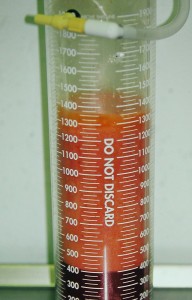The removal of unwanted fat, particularly in the abdomen and waistline, by liposuction is a very common body contouring procedure. While it is preached to patients before surgery that liposuction is not a weight loss procedure but one that only changes body contours, patients are inevitably interested in knowing how much the fat that was removed weighs. While there is no direct correlation between the weight of fat and how much the liposuctioned area changes afterwards, other than the more fat that is removed the more likely the treated body contour will change, the question is an understandable one.
Thus the question of how much fat in weight that one had removed from having liposuction is almost inevitable in any sizeable liposuction procedure. While telling a patient that 2.5 liters were removed, for example and is how liposuction aspirates are seen and recorded by plastic surgeons, that means little to patients who see fat as weight rather than by volume. (although the reality is that patients actually seen their fat in surface area or the convexity of their body contours)
In calculating liposuction aspirate to weight, we start by acknowledging that 1 US gallon equals 3.8 liters. (technically 3.785411784 liters to be exact) Its weight, however, depends on what type of liquid it is. A gallon of water weighs 8.37 lbs. But it would be different if it was a gallon of milk, for example, which weighs in at 8.6 lbs due to the solid components in it. (a gallon of 1% or 2% milk would weigh slightly less) But fat weighs less than water or milk as it is less dense and a gallon of it weighs 7.4 lbs. (the density of fat is 0.9 grams/ml or 1000ml (1 liter) or a weight of 0.9 kg.) Thus, one liter of fat equals roughly 2 lbs. (technically 1.947 lbs)

The interesting thing about liposuction fat weights is that they are not that impressive. Removing 3 liters of fat, for example, would produce a very noticeable reduction in the size of one’s abdomen and waistline. But saying that 6 lbs of fat was removed does sound as magnaminous as how the result will actually appear.
Dr. Barry Eppley
Indianapolis, Indiana


